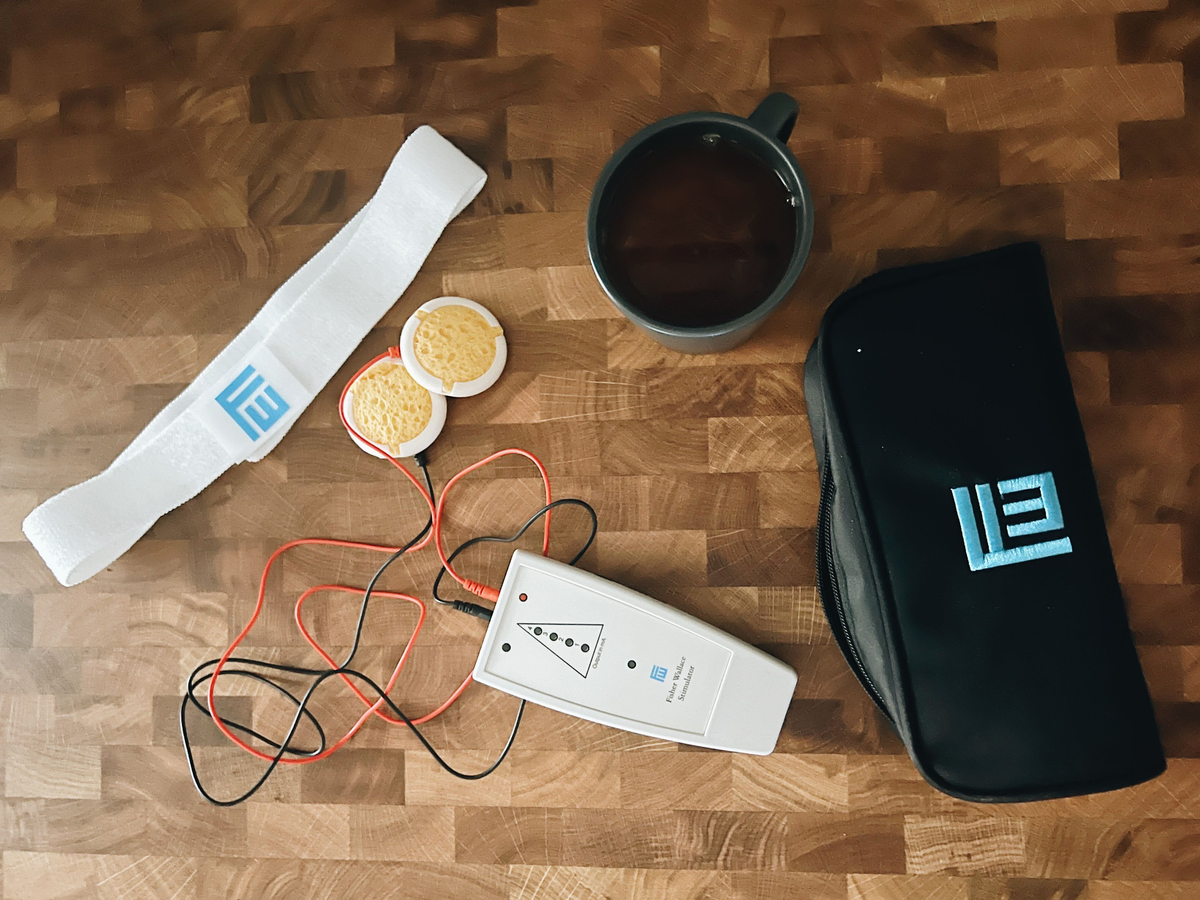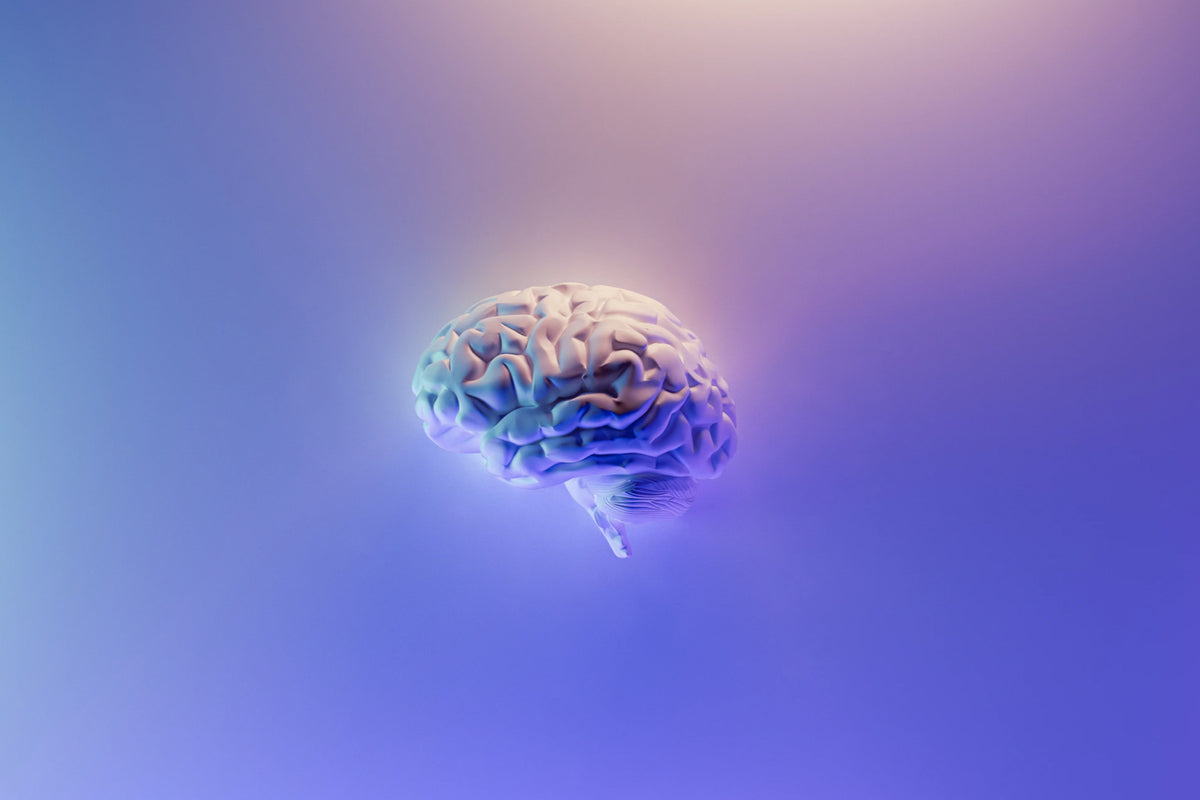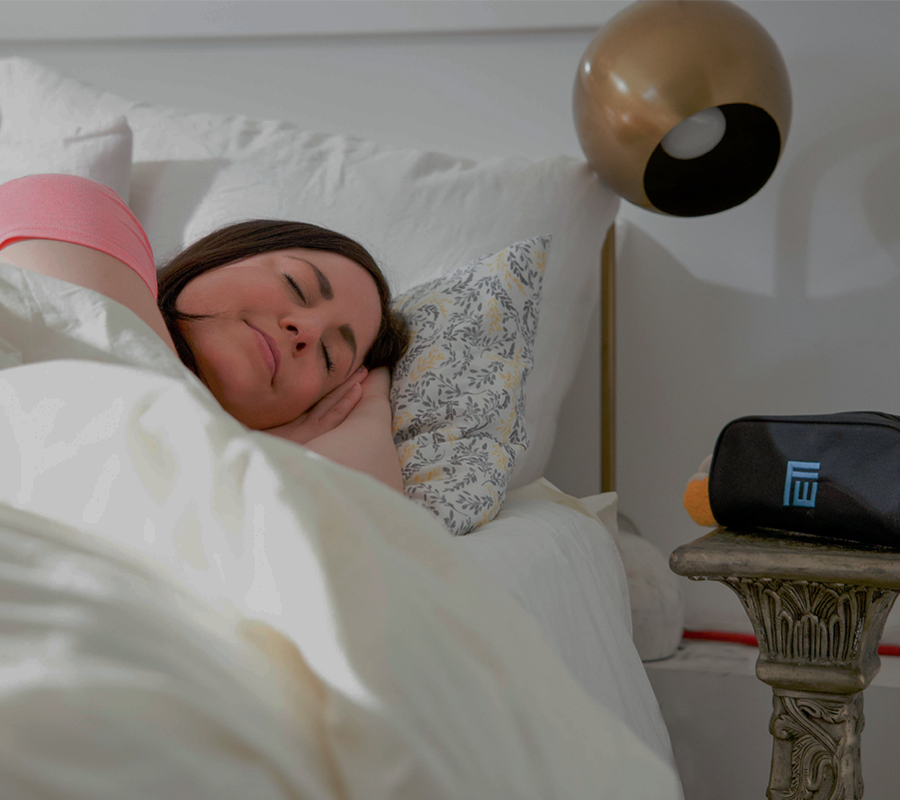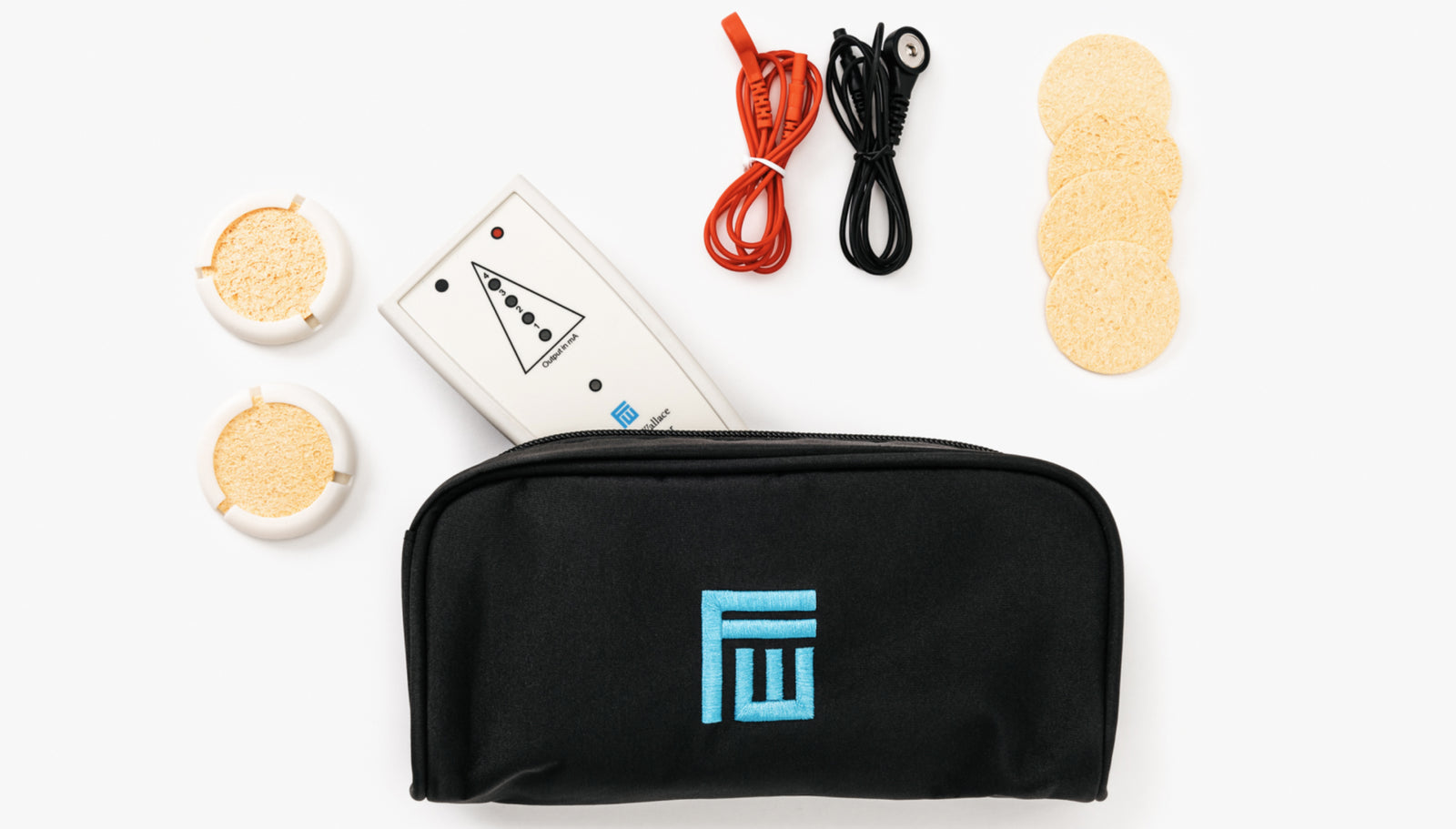How it helps NEW
Our patented technology treats the brain electrically to relieve depression, anxiety and insomnia. It works by stimulating the brain to produce serotonin and other neurotransmitters required for healthy mood and sleep, while also lowering cortisol and modulating the center brain regions responsible for managing the sympathetic nervous system (known as the "fight or flight" response). Most patients report symptom reduction within the first 1-2 weeks of use in clinical trials and practice.

Convenient yet powerful
The majority of depression patients also have clinical anxiety, and often have clinical insomnia. These conditions are interrelated and our technology is proven to address more than one symptom simultaneously as well as individually.
To treat depression and anxiety, patients simply use our device for 20 minutes after waking up, and again for 20 minutes before going to bed. Patients who are only treating insomnia use it once a day before bed. Most patients don't feel the stimulation.
Treatment via our device is easy to fit into your normal routine - resting quietly is best during a treatment session, but it’s fine to do other activities such as reading, watching TV, using the computer, talking on the phone, etc.
The device may be safely used with antidepressants and/or other medications. Do not reduce or stop taking your medication without first speaking to your doctor.
The science behind it

The Fisher Wallace Stimulator® works by gently stimulating your brain to produce certain naturally occurring chemicals that improve mood. One of these chemicals is serotonin, known as the body’s mood regulator. The Stimulator also promotes alpha waves, which resets your brain pattern to a calm state. Additionally, the device helps to lower cortisol, your body’s stress hormone.
In terms of treating insomnia, our technology is not a sedative - instead, the device helps your brain produce a restful state that accelerates sleep onset and enables longer periods of sleep. In our most recent insomnia study, our device increased total sleep time (TST) by 42 minutes more than the placebo device.
Improving sleep is important in and of itself, and it's also a critical means of reducing depression and anxiety.

No serious side effects
The Fisher Wallace Stimulator® has been regulated for use longer than any other wearable neurostimulation device on the market. Over 85,000 people have used the Fisher Wallace Stimulator® in the United States, and over 14,000 licensed healthcare providers have been prescribing our medical device since 2009.
The device has been on the market for decades without any reports of long-term negative effects. Many patients have used the device for years. Less than 1% of patients report a mild, temporary headache or dizziness when using the device.
Additionally, although not a side effect, improper use of the device may result in minor skin irritation beneath the electrode sites - this can occur if the sponges are not thoroughly wet before use or if the scalp and/or hair are not clean.
Watch the Instructional Video
What is the recommended treatment protocol?
To treat depression or anxiety, patients should use the Fisher Wallace Stimulator® twice a day for 20 minutes on Level 2, once after waking up for the day and again before bed. To treat insomnia only, patients should use the device for 20 minutes on Level 2 before bed. It is important to create a consistent routine of daily usage.
If symptoms go into remission (no symptoms), patients may continue using the device to maintain results. There are no withdrawal effects associated with decreasing or stopping use of the device.
May I use the device in combination with medication?
Yes. The device does not negatively interact with any medication and may be safely used with antidepressants and/or other medications. Do not reduce or stop taking your medication without first speaking to your doctor.
Should I use the device every day?
It’s recommended that you use the Stimulator® for 20 minutes a day until symptoms go away. When depression, anxiety and/or insomnia symptoms are completely resolved, you may stop using the device. If you feel that your symptoms are significantly reduced but did not go away completely, you may continue to use the device daily. Many people continue using their device after their symptoms go away because they find they can focus and concentrate better, which are additional benefits that the device provides.
Is there anyone who should NOT use the device?
Patients who have implanted, electronic medical devices, such as an implanted nerve stimulator or pacemaker, should not use the device, as the device may interfere with implanted electronic devices. The device should not be used if you have demand or sensing type cardiac pacemakers.
Additional precautions:
- This device should not be used around the Carotid sinus.
- If you have known or suspected heart disease, you should not use the Stimulator®.
- If you are pregnant, you should not use the Stimulator®.
- If you have reacted poorly to the idea of electrical stimulation of any kind, you should not use this device.
- Discontinue use if your skin becomes irritated around either electrode site.
- This device must be used only for the purpose for which a physician or healthcare professional has prescribed or authorized.
- This device must only be used by the person for whom the prescription or authorization has been written.
How it compares
Compared to drug therapy, ECT and TMS, the Fisher Wallace Stimulator® is the only treatment that is free of serious side effects, can be used at home, and offers a 30-day refund policy.
| Fisher Wallace | Drug Therapy | ECT | TMS | |
|---|---|---|---|---|
| Indicated for Depression | ||||
| Indicated for Anxiety | ||||
| Indicated for Insomnia | ||||
| Free of Serious Side Effects | ||||
| Used at Home | ||||
| 30-Day Refund Policy |
How does the Fisher Wallace Stimulator® differ from Transcranial Magnetic Stimulation (TMS)?
The Fisher Wallace Stimulator® has been cleared by the FDA for the treatment of insomnia, anxiety and depression. TMS is cleared by the FDA to treat depression, but not anxiety or insomnia, and is not an at-home treatment modality.
According to the FDA, TMS also poses a risk of seizure. The Fisher Wallace Stimulator® does not cause seizure or any other serious side effects.
How does the Fisher Wallace Stimulator® differ from Transcranial Direct Current Stimulation (tDCS)?
Neurostimulation devices such as the Fisher Wallace Stimulator® are cleared by the FDA for the treatment of insomnia, anxiety and depression.
Transcranial Direct Current Stimulation (tDCS) is not cleared by the FDA for the treatment of depression, anxiety or insomnia. tDCS was FDA approved in 2004 for Iontophoresis, which is a noninvasive method to deliver medicine or other chemicals through the skin with external patches and a small electrical charge. Transcranial Direct Current Stimulation (tDCS) is not typically an at-home treatment modality, and as a result, can be very expensive because it often requires office visits and doctor supervision during treatment sessions. Insurance companies will not reimburse patients for purchasing or using tDCS for “off label” uses such as the treatment of depression.
How does the Fisher Wallace Stimulator® differ from Electroconvulsive Therapy (ECT)?
The Fisher Wallace Stimulator® and ECT both deliver alternating current to the brain for therapeutic effect, but at vastly different doses. The Fisher Wallace Stimulator® provides very gentle stimulation therapy designed for daily home use without doctor supervision - it does not cause a seizure or serious side effects. ECT, while often effective, is performed in a hospital while the patient is under anesthesia and is designed to induce a seizure. ECT often causes memory loss. Following are more differences:
1. ECT delivers 800 – 1000+ mA of electricity, which causes a seizure.
The Fisher Wallace Stimulator® delivers 1 – 4 mA of electricity, which does not cause a seizure. In fact, the Fisher Wallace Stimulator® is recommended for treating substance abuse patients who are prone to seizures.
2. ECT is administered when a patient is under anesthesia.
The Fisher Wallace Stimulator® delivers such a mild current that patients typically wear it while reading a book, on the computer or watching TV. The stimulation from our device is rarely perceived and is not uncomfortable.
3. ECT delivers a large amount of electricity in a single dose.
The Fisher Wallace Stimulator® delivers a gentle amount of electricity on a daily basis.
4. ECT typically costs $30,000 and, while effective initially, its effects wear off.
The Fisher Wallace Stimulator® costs $499 and the effects do not wear off when the device is used on a regular basis.
5. ECT is indicated to treat severe depression.
The Fisher Wallace Stimulator® can be used to treat temporary or situational depression as well as chronic, severe depression. Our device has also been cleared by the FDA for the treatment of anxiety and insomnia.
